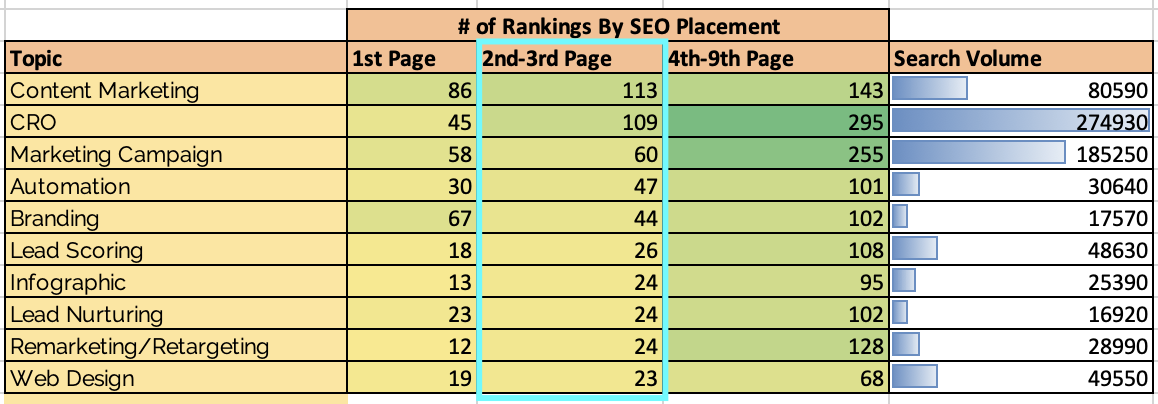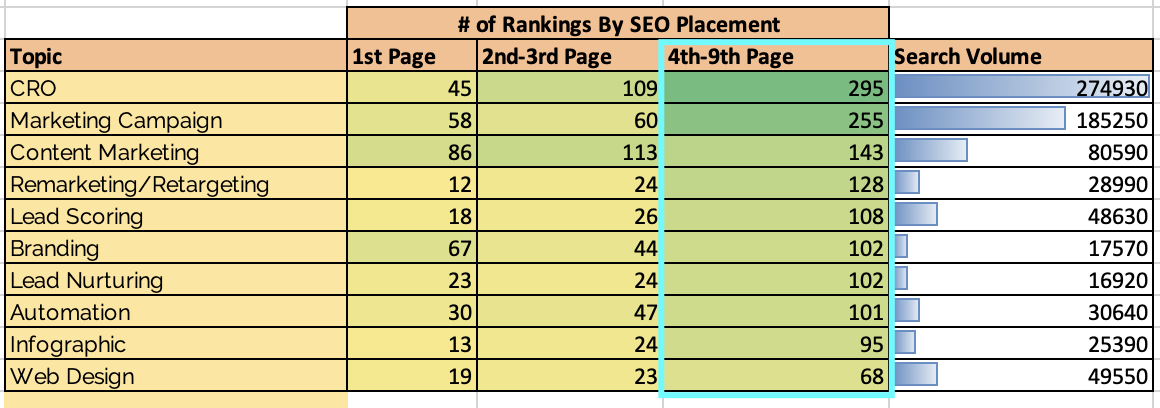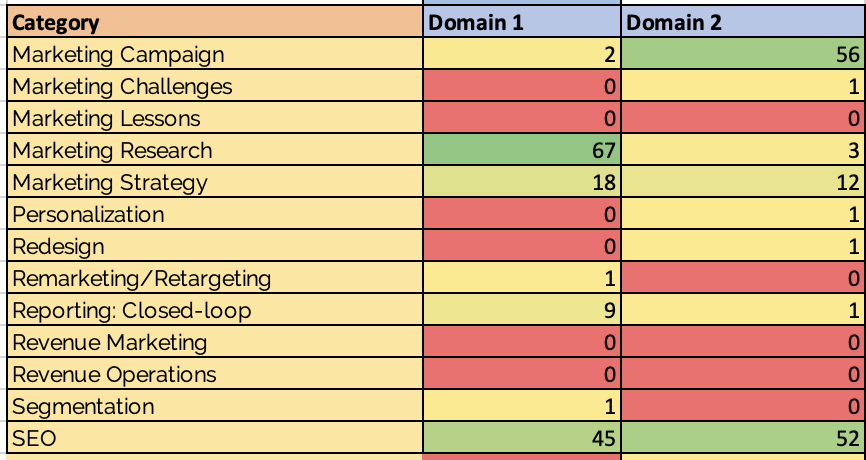Gone are the days when you could pick any keyword, write a 500-word blog post, and show up in the search results.
As search engines have evolved, algorithms have prioritized content based on intent, website authority, and what is going to most sufficiently satisfy their searcher’s needs – even if that means answering the query directly in the search engine results page (SERP).
Why Keyword Categorization Is Important
More marketers are moving to a topic cluster-based approach to SEO, though this is by no means the only way to help you drive organic traffic.
One of the major benefits to this approach is that it forces you to measure SEO success based on buckets of semantically related keywords versus ranking for a single keyword.
This is where keyword categorization comes in.
By categorizing keywords for yourself, your SEO competitors, and your direct competitors, you have a benchmark from which to begin planning your content strategy.
Basic Methods for Keyword Categorization
Whether you use a rough Excel method for filtering/tagging your keywords or take a more advanced approach through Python, BigML, or another programmatic method, the end goal is that you have a semantically related and categorized keyword list.
SEMrush’s keyword gap tool is one of the easiest ways to pull an inventory of keyword data for yourself and your competitors to get you started.

This tool allows you to pull rankings for five competitors at a time.
You will need to merge tables if you have a larger set of competitors to analyze.
4 Ways to Use Keyword Categorization to Identify Opportunities
Now that the hard work of categorizing is over, it’s time to pull out the key SEO insights.
Here are four areas to help plan your content strategy:
1. Low-Hanging Fruit Topics
Identify the topics that have a higher volume of keywords on the second and third page of Google compared to other topics.
In the short term, this is your quickest return on investment from a keyword targeting perspective.
In this example, we can see that this domain has 113 “content marketing” related keywords on the 2nd and 3rd page of Google.
Now that your keyword research data is well organized, you’ll also be able to tell which URLs are ranking for these 113 keywords.

Focus your efforts on improving, expanding, consolidating, and/or optimizing these existing pages (blogs, website, or landing pages) that are on the verge of ranking on the first page.
2. Mid-Range Topics
These topics would include a higher volume of keywords on pages 4-10 of Google search results.
Yes, you are ranking for these topics but it will usually take a significant overhauling of this content to get it to page one on Google.
Here is an example of the topics sorted by the number of keywords on the 4-9th page of Google:

Your options are mixed for your mid-range topics.
Depending on the competitiveness of your vertical, you may be able to revamp what you already have or you may need to bulldoze everything and start over to get to page one. For competitive topics, it’s likely the latter.
3. Long Shots
This includes topics where you have very little to no rankings for these keyword groupings.
Your focus on long shots will depend on how well your topical groups align with your goals. You’re likely going to have a number of categories you barely rank for at all.
Your overall goal shouldn’t be to have an SEO footprint in every category.
Instead, focus on the few categories that have a direct correlation to sales (via attribution reporting).
4. Competitive Insights
The other major value of categorizing keywords is by identifying what factors are helping other sites succeed in the SERPs.
Here is a framework for how you can more deeply analyze competitive data.
First, identify what topics are strengths or weaknesses for competitors.
In this chart, we can see that Domain 1 ranks well for “Marketing Research”-related keywords, but it doesn’t rank as well for “Marketing Campaign”-related keywords.

Now we can go deeper into each competitor’s domain to understand the variables that are helping them ranking well in search. These could include:
- Information architecture: How are the websites structured for the top-performing sites compared to yours?
- Content formats: What kinds of content are ranking well? Do pages with video or imagery rank better than long-form text-only pages?
- Depth or length of content: What is the average word count for the top-ranking pages? Long-form content doesn’t mean you’re going to rank better but in some verticals, it can make a difference.
- Backlink profile: What are the quality and sources of links to the top-performing topics? How many links do the top-ranking pages for that topic have?
- Content quality: How well does the content meet the user’s intent? How well do certain pages cover the topic? Tools like Frase.io help with this process by quickly helping you understand what topics are covered in the top 20 ranking SERPs.
This example shows us the concentration of topics that exist across the top-ranking pages for [what is competitive analysis]:

Now that you understand why certain pages rank and what it will take to get your site to rank higher for your intended topics, you can begin aligning the resources toward your content creation, SEO, or website development efforts.
Aligning Topics With Business Goals
Depending on what your goals are this year, you can use this wealth of data to help you align your stakeholder resources, timelines, and campaigns.
Here are two types of goals you can align this topical research around:
General Revenue or Sales
For general revenue or sales goals, use your customer relationship management (CRM) solution and analytics to understand what pages are on your site that has been given the most organic attribution toward closed won opportunities.
Then, identify the topics that these pages align with.
Some content management systems allow you to tag pages by topic, which will allow you to quickly see which pages are helping the bottom line.
This approach will help you create a business case toward content development, SEO, or website investments that will help you overtake some of your competitors in search.
New or Improved Product Lines
Another common business goal is the expansion or release of a new product line.
Categorial topic data can help you understand which competitors are currently owning this space and the types of content required to compete in the SERPs.
In this case, identify the format of content, website hierarchy, and relative search intent to compete in search.
Plan Your Content Roadmap Based on Insights
Now that you know what your strengths and weaknesses are from a topical SEO perspective, you can start laying the groundwork for your editorial calendar development, website redesign, or the expansion and optimization of existing content.
More Resources:
- How to Integrate Content Marketing & SEO
- How to Go Deeper with Keyword Research: Go-to Tools & Techniques
- Content Marketing: The Ultimate Beginner’s Guide
Image Credits
All screenshots taken by author, March 2021





![[SEO, PPC & Attribution] Unlocking The Power Of Offline Marketing In A Digital World](https://www.searchenginejournal.com/wp-content/uploads/2025/03/sidebar1x-534.png)